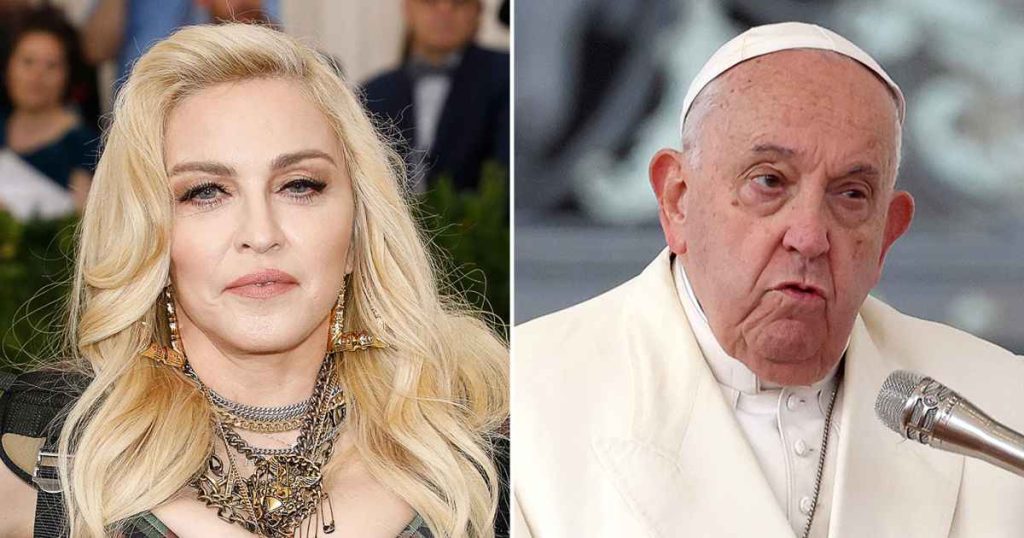Madonna’s recent foray into the realm of artificial intelligence-generated imagery has sparked controversy, reigniting longstanding tensions between the pop icon and the Catholic Church. The image in question, shared on Madonna’s Instagram Story, depicted the singer in a seemingly affectionate embrace with Pope Francis. While the image was clearly a product of AI manipulation, its realistic appearance and the accompanying caption, “Feels good to be seen,” ignited a firestorm of criticism on social media, with many deeming it disrespectful and inappropriate. This incident underscores the complex relationship between art, technology, religion, and public perception in the digital age.
The image, created by AI artist Rick Dick, tapped into a history of provocative imagery and performances by Madonna that have often incorporated religious themes and iconography. Her 1989 music video for “Like a Prayer” featured burning crosses, stigmata, and a Black Jesus, drawing condemnation from the Vatican and religious groups. Her 1990 Blonde Ambition tour was even boycotted by Pope John Paul II due to its perceived sacrilegious content. This latest incident, therefore, is not an isolated event but rather another chapter in a long-standing dialogue, often fraught with tension, between Madonna and the Catholic Church. The AI-generated image, in its simulated intimacy with the current Pope, serves as a contemporary iteration of this ongoing conversation, albeit one conducted through the lens of rapidly evolving technology.
The controversy surrounding the AI-generated image highlights the evolving nature of image-making and its potential for both creative expression and misinterpretation. While Madonna’s intention remains unclear, the image could be interpreted as a commentary on the artist’s complex relationship with Catholicism, a religion that has both shaped her and served as a target of her artistic critiques. The use of AI technology further complicates the matter, blurring the lines between reality and fabrication and raising questions about the ethical implications of manipulating images of religious figures. The swift and largely negative reaction to the image demonstrates the enduring sensitivity surrounding religious iconography, particularly when juxtaposed with popular culture figures known for pushing boundaries.
The backlash against the image underscores the power of social media in amplifying both artistic expression and public disapproval. The rapid dissemination of the image across various platforms fueled the controversy, enabling widespread commentary and criticism. While some may view Madonna’s act as a form of artistic expression, others see it as a deliberate provocation aimed at garnering attention. This incident highlights the challenges artists face in navigating the complex landscape of social media, where the lines between artistic freedom and potential offense can be blurred. The immediate and widespread nature of the online reaction also speaks to the heightened sensitivity surrounding religious figures and the perceived sanctity of their image, especially within the digital sphere.
Madonna’s personal journey with faith has been a dynamic and evolving one. Raised Catholic, she has often grappled with the tenets of her upbringing, expressing both reverence and critique through her artistry. She has described her work as reflecting the teachings of Jesus by promoting unity and freedom of expression. However, her interpretations and expressions of these themes have often clashed with traditional Catholic doctrines, leading to accusations of blasphemy and sacrilege. This ongoing tension between her artistic endeavors and the established dogma of the Church reflects a broader societal debate about the role of religion in contemporary life and the boundaries of acceptable critique. Her more recent identification as spiritual, emphasizing personal practices and a broader understanding of different faiths, suggests a shift away from the rigid confines of organized religion towards a more personalized and inclusive approach to spirituality.
The controversy surrounding the AI-generated image of Madonna and Pope Francis serves as a microcosm of larger societal discussions about the intersection of art, religion, technology, and public discourse. It highlights the potential of AI to both create and distort, to provoke dialogue and ignite controversy. While some may applaud Madonna’s audacity in pushing boundaries, others will undoubtedly condemn her actions as disrespectful and inappropriate. The incident ultimately underscores the challenges of navigating the ever-evolving landscape of digital media, where artistic expression and religious sensitivities can collide in unexpected and often contentious ways. The debate sparked by this image is a testament to the enduring power of both religious iconography and artistic provocation in the digital age.

